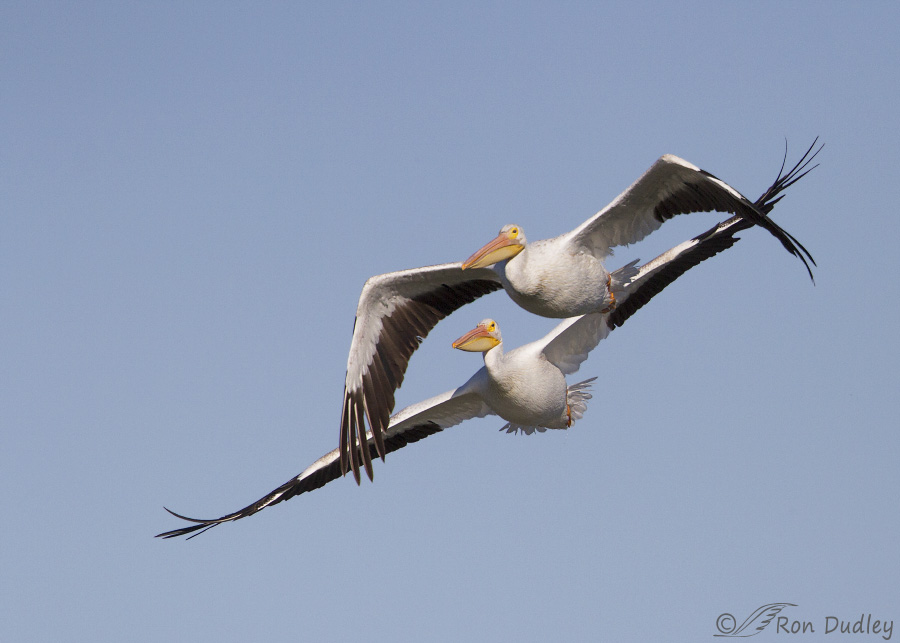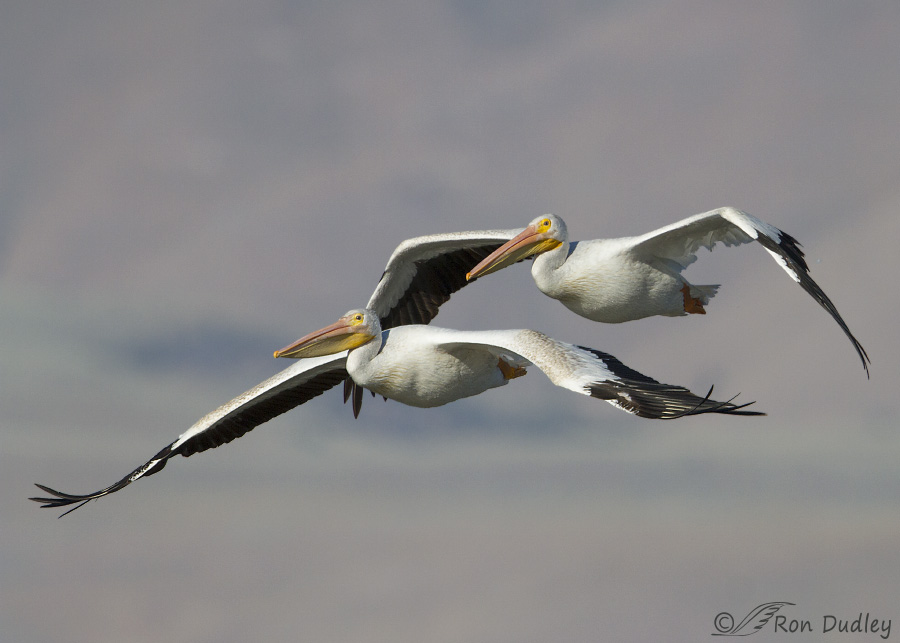Big, lumbering pelicans don’t provide many dynamic flight postures so having two or more birds in the frame can increase your chances of getting something else that the viewer finds visually appealing. For me each of these images, taken a week ago at Bear River Migratory Bird Refuge, has something a little extra provided by the relative positions of the two birds.

I’ve said before that homogenous blue skies aren’t my favorite background. If this image contained only one of the two pelicans (either one) I’d find it pretty boring. But I think the relative position of the rear bird’s head, framed so perfectly by the curvature of the right wing of the nearest pelican, makes up for the plain blue sky background. Both birds are acceptably sharp and even though the pelicans aren’t completely separated they cross mostly at the wingtips so I’m not particularly bothered by it.

Here it’s the apparent proximity of the two birds to each other combined with their similar flight postures that grabs my attention. Similar to race cars it almost looks like the rear bird is “drafting” the bird in front and it’s possible that’s exactly what’s happening. Throw in the interesting background (the Promontory Mountains) and for me the overall appeal of the image is increased significantly.
Some viewers will notice that I haven’t included camera settings and other image techs. I screwed them up in the field – big time, and just decided that I didn’t want to be embarrassed by them.
Hey, it’s my blog. I can do that! 🙂
Ron


I’m very fond of pelicans so both of these make me happy. They are my home state’s bird. 😀
Big lumbering pelicans. Who fly. There is hope for me after all. Perhaps.
That made me smile, EC.
A girl can dream.
For me, since it’s mostly about the birds, the backgrounds may add an element of context, or extra element of interest, but the birds alone are plenty interesting…skies, blurred mountains, etc. are nice but not necessary. I love landscapes, weathered wood, etc. but if the bird is the “main event”, I’m satisfied with or without the “extras”….
As you know, it’s all a matter of taste, Patty. I just get a little tired of blue skies as backgrounds – it’s not that I don’t like them, I just prefer the variety.
The background sky IS especially nice in the second shot….
Beautiful photos. I know the DNR goes to Gunnison Island and bands the juvenile pelicans regularly yet I seldom see a band. I watch for the band when they are in flight or on land. This is an interesting article for anyone who is not familiar with the pelicans in the Great Salt Lake.
http://www.standard.net/Recreation/2014/07/17/Pelican-reef
Thanks for the interesting link, April.
I’ve been watching for those banded pelicans too. So far this year I’ve seen fewer of them than usual.
Hi Ron,
I enjoy your pictures every day and have learned so much from reading your comments and the comments of others who regularly post. I just wanted to pass on my compliments this morning for the images you posted today, specifically the outstanding composition that takes these magnificent photos and elevates them to absolute poetry. I’m not a photographer but I have several friends who are, and I can appreciate the technical skill required to capture these moments that stand still. Thank you again for enriching so many people’s lives with beauty and knowledge.
What a nice comment, Victoria. Much appreciated!
Ron: Absolutely beautiful photos you share – thanks.
Pelicans (brown and white and others) draft often, more or less like Canada Geese. On the shore I have seen flocks of forty and more all in formation drafting of the wings in front of them. Such behavior always amazes me – “dumb” birds doing such neat things.
You’re right about drafting large birds in flocks, Richard. I think it’s fun to watch them as they jockey for position.
You gave me a chuckle this morning. As someone who does look at your settings for learning purposes. Nice pictures anywho!
Good, Jonelle. I hoped I wasn’t being too flippant with that last line.
I like both of these shots. We watch Brown Pelicans here at the beach, and it is always more interesting when there are multiple birds. No need to bear unnecessary embarrassment about the camera settings. What matters is that the photos turned out well (I can say that because I don’t use a fancy manual camera or pay attention to your technical information… 😇)
Thanks Susan. I realize that lots of folks ignore my techs and that’s just fine. But I sure hear about it when I leave them out… 🙂
Nice! The are beautiful in flight and seem so graceful relative to how they look on the water or ground. 🙂 The way the one frames the others head is cool and their positions relative to one another look like they would collide tho I realize the telephoto compresses the distance some. 🙂 Thx for sharing, Ron.
You’re right about the compression of a telephoto, Judy, but these birds, in both photos, were still quite close to each other. Otherwise I wouldn’t have been able to get them both acceptably sharp.
Ron:
I agree, completely, with your assessment of the problem and solution to getting interesting images of the pelicans and I like the two images you posted very much for the reasons you state. I have the same problem with Brown Pelicans along the Gulf coast. Although the brown color may not be as photogenic as that of the white pelicans, their diving behaviors adds a different element to trying to acquire interesting photos.
Thanks, Dave. I’ve often wanted to be able to photograph diving Brown Pelicans but that’s a species I’ve never had an opportunity with.
What gloriously beautiful shots–both are simply spectacular! Insert the ridiculously redundant Oh WOW! here.
White pelicans are one of my favorite birds, especially when they’re doing that outrageous flock thing (how DO they do that?)! I just love it when they do that. It delights my heart.
I’m sure I read somewhere (the where part of this memory is in a black hole somewhere) that the V-shaped flight patterns of geese are similar to the drafting concept in racing. Yet another thing we learned from birds (although I’ll submit that racers had to figure it out themselves rather than listening to the birds who just know this stuff. Note how long it took them to come to that conclusion and use the concept!).
But OK, I’ve got a bit of an insignificant nit to pick. Since the background mountains in the second shot are blurred beyond any sort of recognition, even that there’s a mountain/mountains back there, I’m curious why that’s necessarily a good thing or a bad thing. To my eye, the background could just as easily be a variably cloudy sky. I’d submit that you’re the only one who knows what that background is, so while it’s appealing to YOUR eye, your audience doesn’t know one way or the other unless you disclose the details–and even then, the focus is on the bird(s). However, it’s certainly valid that it’s appealing to your eye! It IS, after all, your blog 😉
“I’m curious why that’s necessarily a good thing or a bad thing”
It isn’t “necessarily” good nor bad, Laura, it’s largely a matter of individual taste. Blue sky backgrounds are so “everyday” that I just get tired of them and appreciate the variety (and added interest) of other types of backgrounds. I don’t have to “know” what the background really is to like one over another.